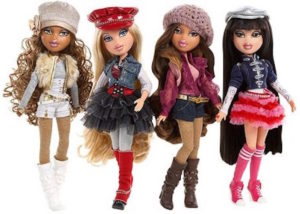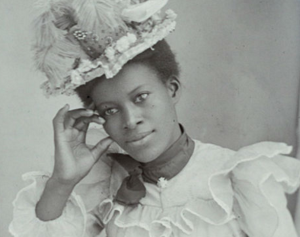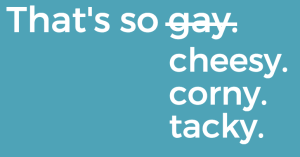Originally published on Ravishly and republished here with their permission.

Four Bratz dolls with long hair, wearing glamorous outfits with high-heeled boots.
“Is it slut shaming to dub Polly Pocket ‘Polly Prostitute?’ No, it isn’t,” Rebecca Hains wrote in response to comments on this Jezebel article by Margot Magowan.
I disagree, but I know where Magowan, Hains, and the artists behind the Bratz doll make-unders are coming from. I really do.
Shopping for Halloween costumes for my daughter when she was three sent me into a seething rage over the aisles full of sexy costumes for the four-to-six age group. It’s both disturbing and distressing that companies market “sexy” to little girls who are way too young to understand what sexy means.
I want parents and others to critique these companies and hold them accountable for teaching girls to focus on appearance above all else – as well as for providing them with such limited options for expressing themselves.
And I can certainly imagine that a time will come when I feel the need to prevent my daughter from wearing certain outfits in public for fear of how people will treat her – even if I know better than to police her choices.
But there are ways to do this that involve sex-shaming and ways that don’t. And dubbing Polly Pocket “Polly Prostitute” most definitely is sex-shaming (not to mention whorephobic).
Hains argues that representations of women and girls can’t be sex-shamed because they’re not real people and therefore can’t feel shame. She says, “Not all criticisms of public displays of sexiness are meant to shame, which is something many people seem to have lost sight of.”
But there’s a difference between intention and impact. And while, of course, a doll or a TV character can’t feel shame, we are teaching our kids to think that certain kinds of clothes are bad.
Mainstream media is already doing a great job of teaching that lesson. I want to find a way to critique the sexualization of girls that doesn’t include adding to it, and I think this is possible. It just involves being really honest – with ourselves as well as with our kids – and thinking carefully about what we’re feeling, what we’re saying, and what our kids are hearing.
As adults, we understand the difference between an outfit for a five-year-old that’s made to look deliberately sexy, and a five-year-old wearing a summer dress that is too small and therefore fits short and tight, and/or rides up over her head when she swings on the monkey bars.
There are certainly people who think both of these things are wrong. I think the latter option is fine – the last thing I want to do is tell my daughter that she needs to cover her body – but the former is not: I don’t want her wearing clothes that are designed to look deliberately sexy.
The question is: How do I explain this difference to a five-year-old?
A lot of adults use the word “inappropriate” to avoid dealing with “sexy” head-on. But I think we empower our kids when we tell them what the real issue is instead of using code words and leaving our meaning open to misinterpretation.
Many parents talk openly and honestly about sex to their young children, explaining it as something that grown-ups can enjoy, but that kids are not ready for. If we can have sex-positive conversations with our kids about sex, we should be able to have those same age-appropriate conversations about sexy clothes without slamming anyone’s style choices.
But as we explain to our daughters that we’re not comfortable with them wearing clothes that are sexy, we also need to make it clear that this is not about covering their bodies. That, in any situation where boys are allowed to be topless, everyone should be allowed to be topless. And that if they want to swing upside down on the monkey bars, it’s nobody else’s business if their underwear is showing.
Unfortunately, many adults think it is their business if your daughter’s underwear is showing, and will not hesitate to let everyone know by shouting at her.
So we probably need to continue this conversation by adding that sometimes it’s just easier to go along with society’s rules and wear shorts under your skirt to avoid public shaming – and that making that choice, for that reason, is okay, too. But the “I disagree with those rules” part of the conversation is super important.
When it comes to talking about toy and media representations of adults or older teenagers (Barbie, Bratz, and yes, Polly Pocket), our critique should focus on the limited representations of women and girls in media.
Why are they all thin and able-bodied? Why are they usually white with straight, blonde hair? Why do they all wear the same styles and colors of clothes? (No value judgment on heels and short skirts, please!)
Not to mention, why don’t people of all genders get to wear those styles and colors? In real life, women come in all sizes and skin tones and have different kinds of clothes and hair. The media should represent all kinds of women, not just one kind.
Coded remarks like “Those shoes don’t look very comfortable” or “She must be cold in that outfit” don’t help anyone. Our kids learn that there’s something so bad about how that doll is dressed that it’s too taboo to talk about.
I’m all in favor of parents voicing their concern about companies that produce sexy toys for children – those companies need to know that parents are unhappy.
But our kids pick up on our attitudes – like when they overhear us talking to friends about “hooker dolls” – they start to realize that “she must be cold in that outfit” is not really about being cold.
And if our attitudes include unchecked sex-shaming, our kids grow up thinking the clothes are the problem. Or, more likely, the women wearing those clothes.
More from Ravishly:
- I’ve Been Harassed Again And Again. Being A ‘Good Girl’ Stops Me From Calling It Out.
- Summer Shouldn’t Be Open Season On Women’s Bodies
- ‘One Of The Guys’: On Cool Girls And Internalized Misogyny
[do_widget id=’text-101′]
Rachel Aimee is a Brooklyn-based parent and writer who enjoys overanalyzing children’s books, finding community with progressive parents, and figuring out how to critically negotiate princess culture without oppressing princess-identified kids of all genders. She blogs at Not Anti-Princess.
Search our 3000+ articles!
Read our articles about:
Our online racial justice training
Used by hundreds of universities, non-profits, and businesses.
Click to learn more
Most Read Articles
- « Previous
- 1
- …
- 30
- 31
- 32



















